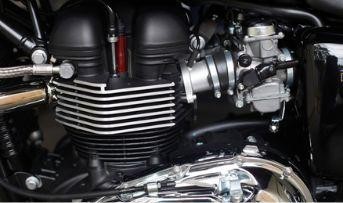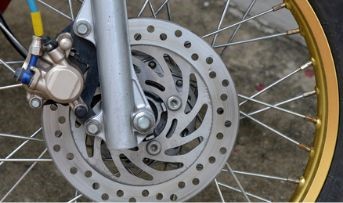General Insurance Blogs, Articles & Updates by - Magma HDI
Have us call you
- RENEW YOUR POLICY
- BUY NEW POLICY

These drive-away destinations make for a dreamlike weekend getaway
Have you ever felt unproductive while having tight deadlines and no creativity or motivation to complete your tasks? You may be facing burnout and are among 40% of the Indian workforce. While it may seem challenging to get out of such a phase, the best way to overcome the symptoms of burnout is to step away from work and hit refresh! What better way to do so than going on a short vacation?
Considering the intense work pressure and hectic schedules, taking a leave may not always be possible. So why not make the best use of your weekends to drive away from monotony? Short road trips are the perfect way to meet your requirements without overspending. Considering the traffic-packed roads across the country, taking your bike on the journey may be ideal.
If you’re convinced, pack light, gather your friends, get your bike serviced, ensure all the papers are in order, and purchase two wheeler insurance online India. Pick a destination from our specially curated list to experience the joy of a quick getaway over the weekend!
1. Cherrapunji, Meghalaya:
Known as a quaint town, the wettest place on Earth is home to unique living root bridges that you must check out. With well-built expressways through scenic greenery, motorcyclists are in for a joy ride on this journey. We recommend starting from Guwahati or Shillong to experience the best of the town’s old-world charm.
2. Goa:
Planning a vacation without mentioning Goa, irrespective of duration, is impossible. With excellent connectivity to neighbouring states, the party capital is the best place to head to if you need tranquillity or happening parties. The ride through the picture-perfect Konkan belt will stay in your memories forever!
3. Ooty:
The rolling hills of Ooty and its lush greenery make for a serene getaway. Enjoy the view of far-reaching sprawling tea and coffee plantations as you drive through valleys on meandering roads.
4. Jaisalmer:
If rough terrains excite the motorcyclist in you, Rajasthan’s cities are the perfect destinations to plan your next road trip. A panoramic view of the beautiful blend of culture, heritage, and vibrancy will follow you as you make your way to the Golden City. Considering the arid surroundings, planning your trip between November and March is suggested. We urge you to purchase two wheeler insurance online India to cover any mishaps you may encounter during your journey.
5. Araku Valley:
At a little over a hundred kilometres away from the City of Vishakhapatnam is Araku Valley, a hill station with rustic heritage, tribal influence, and coffee plantations. While the journey may be short, the valley offers the best nature, biodiversity, and climate, making for a refreshing retreat.
6. Munnar:
If you fancy long-distance road trips, plan your next trip to Munnar, a hill station in Kerala. Its green hills, waterfalls, and tea plantations make for the perfect view on your journey, which may take up to 04 hours if you start from Kochi.
The other popular destinations include Lonavala, Karjat, Alibag, Nasik, Daman, etc. which promise a happening weekend setting for you to unwind and return with positivity and energy.
This list is not exhaustive and only includes some destinations you can consider setting off. While each destination has a unique appeal, we urge you to purchase two wheeler insurance online India before you depart on your two-day vacation! Safety should always be on top while planning bike trips. Wear proper gear and a helmet to safeguard yourself from any mishap.
Click HERE to buy two wheeler insurance online India.
Disclaimer: The information provided above is for illustrative purposes only. To get more details, please refer to policy wordings and prospectus before purchasing a policy.

These are a few ways you can detect bad clutch problems in your bike
Riding a motorbike with smooth-shifting gears gives you a sense of pleasure that no other thing can. The feeling of downshifting into a curve, soaring your RPMs, then switching back into high and rushing down the straightaway is unmatched.
But when the quality of your clutch starts deteriorating, it no longer grips as usual or allows you to smooth down and upshift. If you take too much time to assess a bad clutch, it might leave you stranded during a ride. While the rest of the crew enjoy the journey, you will have to spend extra time repairing or replacing it.
However, knowing the signs of a damaged clutch will help you repair the appropriate pieces before you're left stranded.
In today's post, we'll discuss ways to assess if your clutch is on its way to being damaged. Read along to know how you can avoid costly repairs before it's too late.
1. Slipping of clutch:
The clutch slipping indicates that it has already begun to wear down. You may sense a lag or a slight jerk when your bike starts picking up. The RPM starts to increase faster than it should. If any of these occur, your bike's clutch is worn out, and it's time to get it repaired.
2. Sticking of clutch:
Your bike's clutch will start to stick if there is a malfunction or oil-induced dirt in the springs. It can either stick in or out depending on when the event occurs. The clutch parts will cling together as you change gears resulting in a low-power transmission. A sticky clutch might be mistaken for a general bike problem, so be extra cautious and get it diagnosed.
3. Hard to shift gears:
If your clutch wire is loose or the clutch gap is compressed, the bike will not accelerate because you won't be able to shift gears. When parking your bike, it's best to keep it in neutral, although some people leave it in first gear. So if you ever experience a slack in shifting gears, visit the mechanic.
Tip: To minimise clutch dislocation and overheating, always start your bike in neutral. Overheating the metal components causes them to expand, lowering the spacing distance. However, the clutch relies on friction to transfer power, so oil the parts regularly to avoid overheating.
4. Sharp metallic noise:
If you've recently noticed a strange sound emanating from your bike and it becomes louder as the days pass, it might be your clutch asking for attention.
5. Burning smell:
A burning odour may signal a clutch problem, which you should not neglect. If a mechanical noise accompanies the smell, you should have the clutch pad checked out as soon as possible to avoid any more damage.
These are some ways you can detect a problem with your clutch system. Make sure you always park your bike on neutral. Oil the clutch system periodically, but don't put too much oil. Never use the clutch as the braking alternative unless it's very needful, like in case of brake failures.
While you ensure your clutch pad, insure your bike as well, it will help you in case of mechanic visits for your clutch repairs and avoid additional expenses. Purchase bike insurance online and add value to your two-wheeler with the benefits of comprehensive coverage.
Click HERE to get the best bike insurance online right now.
Disclaimer: The information provided above is for illustrative purposes only. To get more details, please refer to policy wordings and prospectus before purchasing a policy.

Your bike’s cubic capacity can directly impact its insurance premium, here’s all you need to know
Manufacturing date, location, vehicle model, claims history with add-ons, and optional deductibles are a few variables that could impact your bike insurance. However, some other aspects could also influence the cost of insurance.
An essential factor in calculating the insurance premium is the two-wheeler's cubic capacity (cc), also known as its engine capacity. Continue reading to learn how your bike's cubic capacity affects its insurance cost.
What is the cubic capacity of a bike?
The capacity of your bike's engine is measured by its cc i.e., cubic capacity. A bike's engine size is essential since it affects how much power it can produce. A two-wheeler is thought to be stronger if its chamber is larger. Similar to how a four-wheeler vehicle's engine capacity is expressed in litres, a bike's capacity is understood similarly.
Bikes with higher cubic capacity come equipped with large cylinders that can produce extensive power output from the engine. This results in low fuel efficiency as more consumption is observed to drive more engine power output per stroke.
Bikes with higher cubic capacities are expensive. This is because intense mechanical fitness and build are required for the bike to withstand tremendous torque and power. Higher cc bikes have premium quality brake pads, comfortable suspension, and excellent exhaust that can easily overcome the wear and tear that might result from high-speed riding.
What effect does your bike's cubic capacity have on policy premiums?
Your bike's engine power is critical in the premium fixing process. The engine's cubic capacity affects the cost of your motorcycle insurance. A 75 cc bike would be less expensive to insure than a 220 cc bike. Take proper care of your bike's engine to guarantee that it operates smoothly.
Higher cc bikes would cost more to insure because your insurance rate directly correlates to your engine's cubic capacity (cc). When determining the third-party insurance rate, the IRDAI primarily considers the cc of your bike.
A bike's cc majorly determines the on-road cost of the bike. Low-cc bikes are less expensive than high-cc ones. The insurance premium for expensive bikes is more, considering their superior build quality and use of costly parts.
Other elements that affect the insurance premium for bikes with the higher cubic capacity.
Here are the various factors that influence the premium of the higher cubic capacity bikes:
● Geographic location: Compared to Tier II cities or rural areas, the premium is more significant if you stay in a metropolitan metropolis. Compared to non-metro regions, urban areas have a higher risk factor.
● Year of production: The age of the vehicle directly affects the insured amount. The insurance sum will decrease as time goes on since the bike loses value.
● Make and model of the bike: Premiums for high-end/premium bikes are higher; premiums for entry-level bikes are lower.
● Add-ons: In return for a more premium for bikes with higher cubic capacity, add-ons safeguard you against situations that aren't covered by the basic program.
● Installation of security measures: Lowering the danger of theft and the likelihood of damage by installing anti-theft devices or other security measures reduces the insurance price. By installing security devices, you can get a reduction in insurance premiums for bikes with higher cubic capacity.
Every bike driven on the road must be covered by third-party insurance. Therefore, in addition to looking at the bike's qualities before buying one, you should also consider getting bike insurance. Shop around to buy motor insurance online that best suits your needs and expectations. You can reduce the cost of two-wheeler insurance while maintaining adequate coverage if you heed the above suggestions.
Click HERE to buy motor insurance online.
Disclaimer: The information provided above is for illustrative purposes only. To get more details, please refer to policy wordings and prospectus before purchasing a policy.

These advanced technologies are making motorcycle rides safer and how
The ever-increasing number of vehicles on Indian roads is constantly posing a risk to the safety of drivers, riders, and pedestrians. While purchasing the best two wheeler insurance in India is a mandatory requirement, several advanced technologies have also evolved to make motorcycle rides safer. These technologies are helping to reduce the number of accidents and enhancing road safety.
Let us have a look at them in detail.
1. Anti-lock braking system:
An anti-lock braking system or ABS is a technology that prevents a motorcycle’s wheels from locking when sudden brakes are applied. Hurried braking is usually used when an object or a vehicle appears suddenly in front of the bike. This may cause our motorcycle to skid and cause serious bodily injuries and even damage to the bike.
ABS makes use of speed sensors that are fitted on both wheels. It senses that a wheel lockup is about to occur and instantly reduces brake pressure. This prevents the motorcycle from skidding, preventing an accident.
2. Wearable airbags:
We have always known that cars come equipped with airbags that open up instantly at the time of a car crash. They minimise the impact of accidents and help to save lives. Most of us do not know that wearable airbags for bikes are now being made with the help of modern technology that performs a similar function as cars’ airbags at the time of a crash. Wearable airbags are put into a vest and can be worn with a compatible jacket. The airbag inflates during a collision and then deflates automatically. It cushions the rider and the pillion rider, minimising the crash's impact. These airbags can be a lifesaver and protect the upper half of the body. Also, these airbags are universal in nature and can be used with any motorcycle make and model.
3. Motorcycle alert systems:
Modern technology has enabled the incorporation of radar sensors that can scan our surroundings and identify potential dangers, even in motorcycles. These sensors can help us map the vehicles around us and alert us of any possible collision. They can also warn us of approaching vehicles or if a vehicle gets too close to us.
Motorcycles nowadays also come with sensors that alert us if our kickstand or side stand is open by flashing a light on the display panel. This helps avert a possible crash due to the open kickstand while riding.
4. Advanced lighting:
Motorcycles now have advanced LED lighting systems that produce optimal beams for enhanced street visibility. This minimises the chances of an accident due to poor visibility on the streets at night or during heavy fog conditions. Also, motorcycles have hi-technology illumination systems that enhance their visibility in poor light conditions.
5. Modern helmets:
Helmets are being made with advanced technology, making them lighter and sturdier. Modern-day helmets make our rides safer and protect our heads better than older models of helmets at the time of a crash.
Helmets nowadays also come equipped with hi-tech Bluetooth headsets and good-quality cameras. They help bikers stay connected during a ride, especially in difficult and risky terrains. The cameras are capable of capturing minute details during a ride. Riders can go through the recordings after finishing their ride and make a note of the possible improvements.
Modern technology is a blessing in reducing the number of road accidents. These innovations might cost us money, but they are worth every penny spent on them as they reward us with a safe journey. Two wheeler insurance also makes our motorcycle rides safer by protecting us financially in case of a crash. Choose the best two wheeler insurance in India to ensure complete motorcycle coverage and hassle-free claim settlement in times of need.
Click HERE to buy the best two wheeler insurance in India.
Disclaimer: The information provided above is for illustrative purposes only. To get more details, please refer to policy wordings and prospectus before purchasing a policy.


